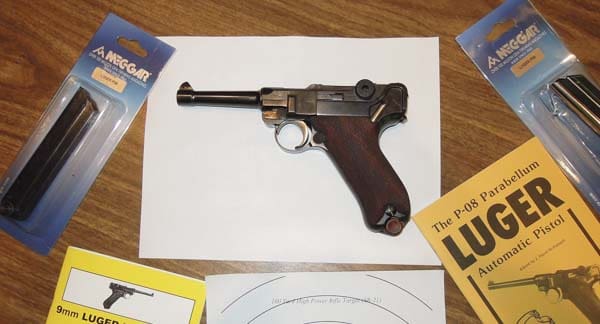
(This is a reader-submitted review as part of our gun review contest. See details here.)
By Doug G.
What happens when a dog finally catches a car it’s been chasing? Gun collecting is an aspirational hobby. Once most enthusiasts acquire the firearms they “need,” they move on to “wants.” If I am being perfectly honest with myself, my needs only include a carry pistol, a hunting/sporting shotgun, and a big game hunting rifle. A home defense weapon is a need, but could be satisfied by one or more of the foregoing. Nevertheless, we can always recognize a need for a more specialized firearm (a dedicated trap gun, a choice of carry options to best suit wardrobe or weather, a small game rifle, etc.).
Additionally, as we use and practice with our firearms, we often realize (or rationalize) that one or more of our guns that previously satisfied a particular need are not quite as good for their role as that shiny object we read about in TTAG. My wife will tell you that all my needs are satisfied and that I don’t have to get any more guns. Methinks she doesn’t understand.
Having said all that, there are definitely “wants” that in no way, shape, or form can be convincingly characterized as “needs.” Most of us have a bucket list of our firearm wants: e.g., a Wilson Combat 1911, a Grizzly Customs lever gun, or an out of production historical weapon.
I have now satisfied one of my wants: a P-08 Luger.
Acquisition
Three years ago, I handled my first P-08 in a small gun store while on vacation in Michigan. I didn’t buy it: the price was too high, and I didn’t have enough Luger knowledge at that point to make an informed purchase. Nevertheless, I left that store knowing that I wanted a Luger. Badly. Why?
Georg Luger designed one of the world’s most iconic pistols. It was one of the first modern, mass produced semiautomatic, detachable box magazine-fed handguns. It was the first gun chambered in what is now the world’s most popular centerfire handgun cartridge, the 9x19mm (also called the 9mm Luger). Finally, it’s just plain cool-looking.
After some lucky bidding in a recent Rock Island Auction (my bid was below the expected $1300-$1800 gavel price), I finally acquired my Luger. Due to my general distaste for all things Nazi, I limited my search to Lugers manufactured before and during World War I. From 1908-1918 there were two main manufacturers of Lugers: Deutsche Waffen und Munitionsfabriken (DWM) and the Erfurt Arsenal.
My specimen is an Erfurt model that was manufactured in 1911 (why does that date seem familiar?) with the standard 4” barrel. It is serial numbered 276 and has matching numbers on most of its constituent parts, including the magazine. It has a variety of proof marks which, based on the results of my online searches, indicate that it was a military issue with a later arsenal modification to add a toggle hold open on an empty magazine–a feature that was not present when the gun was manufactured.
When I opened the box and held it for the first time, I was floored by how good the condition appeared. The auction house had indicated that the pistol was non-professionally refinished. While this fact likely diminishes the value for avid Luger collectors, the gun itself looks to be in remarkably good shape and the blued and the straw finish (gold-colored) portions appear in great shape. I sense that the straw finish may wear off if it is handled too much, though.
Per the limited information from Rock Island Auction, the pistol has all original parts and better than 30% of the original finish. It is also listed as having an “A B/5” crossed scepter proof stamp between the trigger guard and the back side of the takedown pin. (To my eyes, it looks more like crossed swords than crossed scepters, but I’ll let you, the reader, decide–see photo below.)
I haven’t been able to track the meaning of that particular stamp, but I think this may be a British mark indicating it was captured or otherwise officially brought into Britain at some point. There do not appear to be any Nazi stamps so if it was captured, my guess is that it happened during WWI.
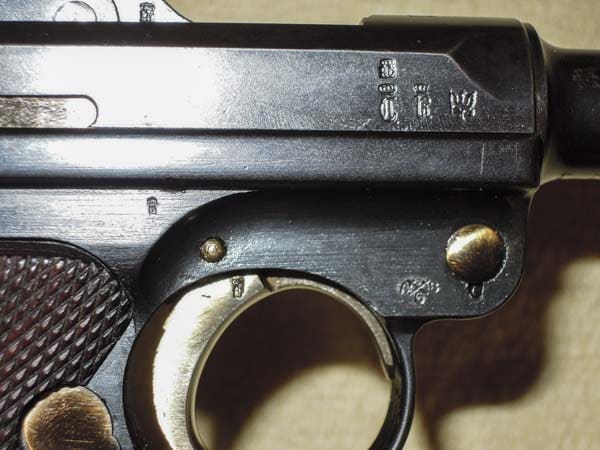
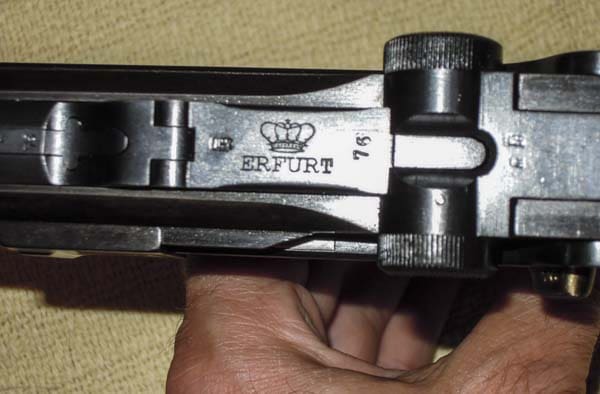
Initial impressions
Overall, the pistol is tight. Everything fits perfectly with no play in any of the parts. Almost all of the weight is in the grip or just above the shooting hand. To my eyes, with its sleek lines and tapering barrel, it is an elegant gun.
While the ergonomics of the grip and the pointability of the pistol are excellent, the gun’s sights are not user-friendly. The front post is barely visible through the tiny rear “v” notch and appears to bounce around more than I am used too. The thin profile and light weight of the barrel contribute to this problem.
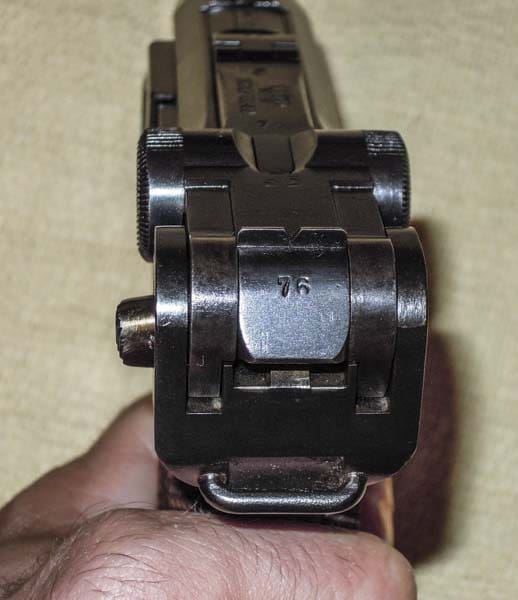
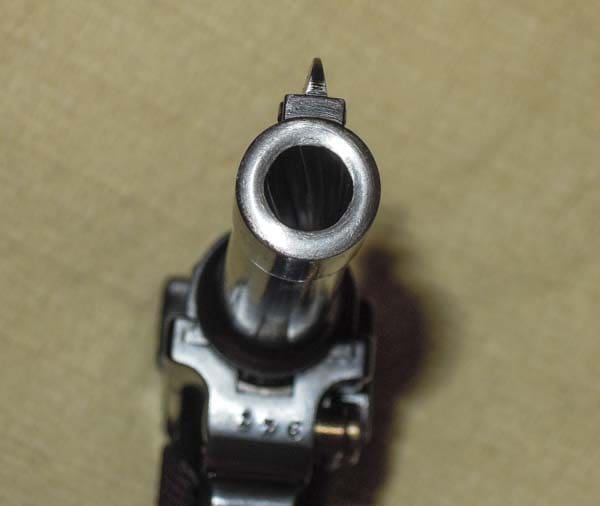
The magazine release is on the left side of the frame behind the trigger guard, similar to what most of us in the United States are used to. For my medium/small hands, however, it is placed too far forward and requires me to change my grip in order to drop the magazine. Tactical reloads will not be smooth with this pistol.
Most semi-automatic pistol designs use a reciprocating slide to chamber the initial round. After firing, the slide moves back to eject the empty shell casing and load a new cartridge. The Luger does not have a slide. Instead it has a toggle action that goes up and back, like bending a knee, to chamber, eject and load.
The extractor is on the top of the action and acts as a loaded chamber indicator, protruding slightly and exposing the word “Geladen” when the gun is loaded. Spent casing are ejected through the top of the action and tend to fly backwards (I caught one in the forehead while testing). The Toggle is tight and pulling it is made easier if you point the pistol up at a 30-45 degree angle as you work the action. To release a locked back toggle, drop the magazine, or insert a loaded magazine, and push back (or pull back) on the toggle.
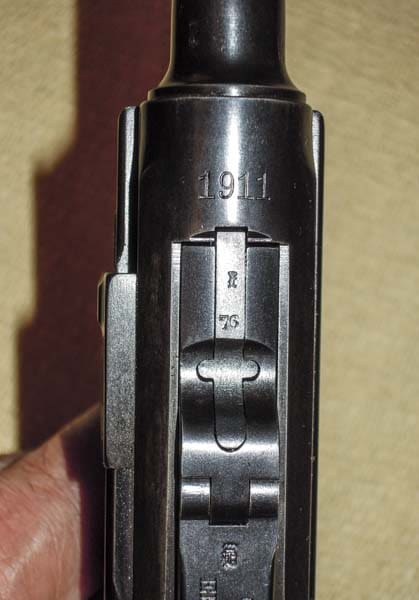
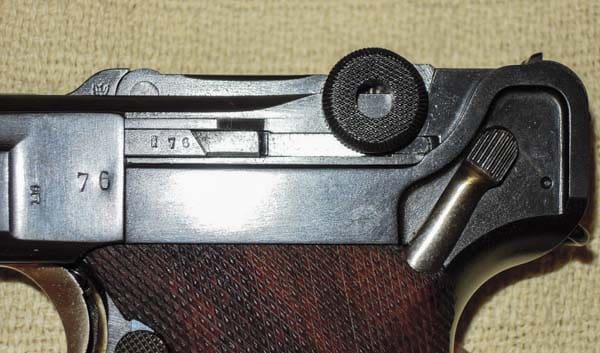
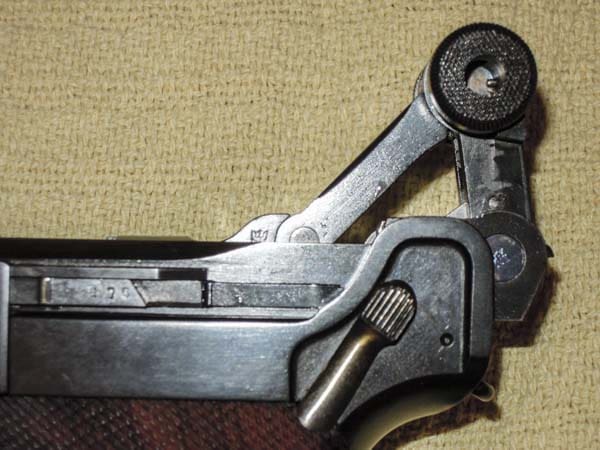
The manual safety on the luger is located on the left side of the frame above the thumb of a right-handed shooter. When in the up position, the gun is in firing mode. When down, it is on safe and the German word “Gesichert” (safe) is visible. Its design does not allow for an easy on/off sweep with the shooter’s right thumb like on an M1911.
The crisp trigger has very little take up and no creep. I do not have a way to measure trigger pull weight, but based on experience, I would judge the trigger pull to require 7-8 pounds. It is consistent and repeatable and quite good. There is no hammer on the pistol, so re-cocking requires the toggle action to be worked.
Initial Shooting Impressions
Because I couldn’t wait to load it and try it out, and because I had limited time after picking up the pistol, although I fully inspected the pistol, I did not field strip and clean it before taking it directly to the range.
I was not sure the original magazine would function so in preparation for the gun’s arrival, I ordered two spare Mec-Gar P-08 magazines. I brought those with me to the range.
NATO spec for 9mm ammunition is 124gr, the same as original Luger loads, but I couldn’t find any 124gr hardball in my stash, or at Gander Mountain. What I brought with me was 200 rounds of Winchester white box 115gr FMJ, 50 rounds of Remington 115gr white and green box JHP, a couple boxes of Hornady 115gr Critical Defense, and a box of Speer 115gr Gold Dots. I did not end up using any of the Hornady or Speer rounds.
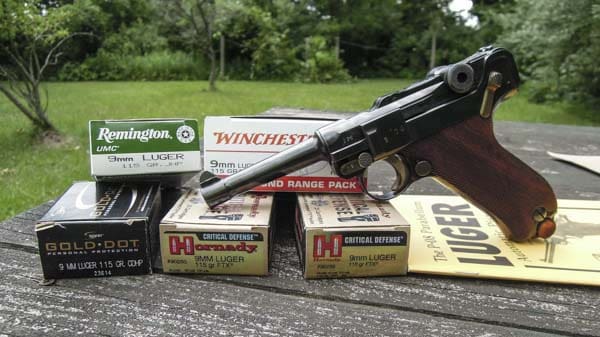 Toggle: locked back on empty magazine. Safety off.
Toggle: locked back on empty magazine. Safety off.
Loading a Luger magazine is comparable in difficulty to loading Ruger Mark I and Mark II magazines–and those can be a royal pain (perhaps because Bill Ruger based the design of those guns on the Luger). For my first trip to the firing line, I loaded 5 rounds of the Winchesters into the original magazine (Luger magazines are designed to hold 8 rounds).
When I stepped up to the 20’ line for the first time, it took a while to align the sights.
Ready, aim, press, BANG.
Ugh. 8” to the right of point of aim and a little down.
Let’s try again. Ready, aim, press, BANG.
That’s better. On the target about 1” left and 1.5” below the bullseye.
Third shot. Ready, aim, press, BANG.
Wow. I’m starting to like this. Just above the bullseye.
Fourth shot. Ready, aim, press, Nothing. Not even a click. Press again, nothing.
HMMM. This was odd. Round three’s case properly ejected, round four was chambered, the pistol appeared in to be in battery. I extracted round four. On inspection, there was no dimple in the primer. The firing pin never actuated.
Oh well, let’s chamber round five and see what happens. Ready, aim, press, BANG.
A couple inches left of the bullseye-not bad.
I reloaded the fourth round and fired. Just below bullseye.
After the first five rounds, the pistol seemed fairly accurate. I assumed the first round flyer was a fouling shot.
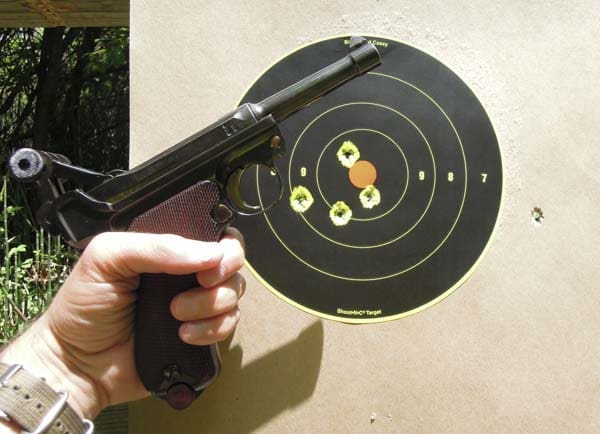
Was the problem the magazine? I next tried one of the Mec-Gar magazines. The results were worse. The first two shots worked, but then I had another failure to cock. Unloaded round three. Loaded round four in the chamber. It worked, but round five which followed it, did not: pull the trigger-no click, no nothing. Extract round five and then shoot each of round three and five as a single shots.
The results were much the same for the second Mec-Gar.
I tried loading eight rounds in the original magazine with similar results-I was lucky to get two rounds in a row to fire.
The pistol consistently extracted and loaded, but seemed to have a failure to cock upon returning to battery.
I was getting frustrated but decided to try a different load of ammunition. I put five rounds of the Remington 115gr JHP into one of the new magazines and had similar results.
Most of these strings of fire were taken standing with a firm two-handed grip from a modified isosceles stance. I did, however, take 5 shots one-handed from a bullseye stance.
At this point, I decided I needed to field strip the pistol, do a thorough cleaning, and retry the gun with 124gr ammunition.
Field Stripping
The Luger is a remarkably well-designed machine and when I removed the top from the frame for the first time, I said out loud (to the empty room) “this is so cool!” To take off the top, push back the barrel about ¼” and turn the takedown pin down 90 degrees (located above and in front of the trigger guard on the left side of the gun). Remove the side trigger plate directly behind the takedown pin, and then slide off the barrel and action.
The toggle system (which includes the firing pin housing) can be removed by pushing out a pin in the back of the barrel system. Use a flathead screw driver to twist out the breech-block end piece that holds in the firing pin and firing pin spring (careful, don’t let it shoot across the room), and you are basically ready to start cleaning.
After I gave the Luger a full cleaning with Break Free and applied RemOil, I was ready to take it back to the range.
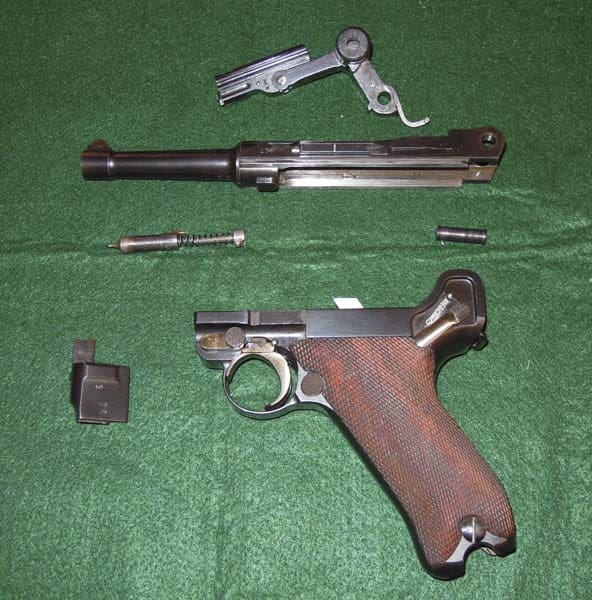
Shooting Impressions-Second Trip to the Range
In preparation for my second trip to the range, I purchased a box of Blazer 124gr FMJ cartridges.
During this range session, I fired a total of 33 rounds, 28 of the Blazers and 5 of the Winchester 115gr white box. I alternated among my three magazines and initially shot 5-round strings and mixed in one 8-shot string. All shots were taken from 20’ away and were shot standing using a firm two-hand grip from a modified isosceles stance.
Unfortunately, the results were largely the same as my initial session, with one slightly disconcerting difference. On four occasions, after the gun had failed to fire a follow-on shot after I pulled the trigger on the newly chambered round, when I pressed the trigger a second time, the gun discharged.
This had not previously happened when I gave the trigger a second (or third) press following earlier failures to fire, and it did not happen every time there was as a failure to fire during this range session. These were merely quick follow-on trigger presses to confirm that nothing was going to happen. When the gun fired following the second trigger press for the first time, I was very surprised. Even with these surprise discharges and the heavier weight bullets, I never was able to string together more than 4 shots in a row.
Not that an informed TTAG reader needs to be reminded of this, but I’ll state it anyway: Always keep your gun pointed downrange.
Notwithstanding these difficulties, the pistol proved accurate. All 33 rounds were on the target at 20’. About 80% of them were in a vertical 4”x1½” box. Most of the flyers were a result of the surprise discharges.
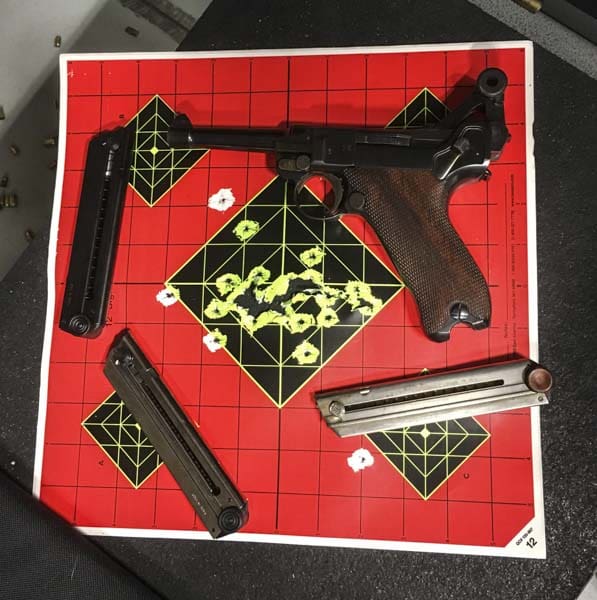
Conclusion
The pistol itself is beautiful. At 105 years old, it is accurate and feels great. On the other hand, this is not the pistol to bet your life on. It fills no need. It was a want, and now it is a “have.” It will never be a carry gun, and I am more likely to show it off than shoot it. I will try to fix it to make it more reliable and I will certainly spend more time researching its various proof marks to better understand its history.
So, in answer to question at the top of this review, when this dog finally catches one of the cars it’s been chasing, he cleans it up and finds a place of royalty in his safe to keep this safe queen comfortable and protected.
Specifications: P-08 Luger
Manufacturer: Erfurt Arsenal
Model: Military P-08 Luger
Manufacture Date: 1911
Type: Semiautomatic pistol
Operation: Recoil operated (toggle action), striker fired
Action: Single action
Caliber: 9mm Luger (9x19mm)
Magazine capacity: 8
Barrel length: 4″
Trigger pull: 7-8 lbs.
Sights: V-notch rear, dovetail mounted front
Finish: blued steel with some straw finish parts
Grips: 2-piece; checkered walnut
Overall length: 8-1/2″
Height: 6-1/2″
Width: 1-1/2″
Weight: 30 oz (with empty magazine)
Country of origin: Germany
Price: Depending on condition and provenance $750 to more than $3000
Ratings (out of five stars):
Reliability *
It reliably fired every cartridge that was loaded by hand operation of the toggle, and it ejected all empties and loaded the next rounds out of the magazine. Unfortunately, it would not reliably fire the newly loaded round. If you need your gun to go boom every time you pull the trigger, this is not the gun for you.
Accuracy * * * *
Once you are able to acquire a sight picture with the tiny sights, the gun fires to point of aim.
Style * * * * *
This pistol has a silhouette that is recognized around the world. The model was standardized in 1908 and it’s still in fashion.
Customize This *
Spare parts are available and you can purchase original or new flap holsters, if you desire. Snail drum magazines are an available, if expensive option, but there are not a lot of readily available gegaws with which to gussy up this classic.
Overall * * * * *
It’s a Luger. The design is timeless, the fit and finish is solid. It is a piece of history and, at 105 years old, I’m impressed it works as well as it does.



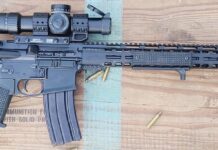
I enjoyed that article, well done.
A lot of the Luger’s problems, not saying this is what is happening with this pistol, are based on the ammo issue. For decades the one factory load available in this caliber was 124 grain fmj loaded fairly hot.
I don’t know when the changeup to fairly pedestrian 115 grain loads started but it has had an effect on older guns. Maybe the ammo makers are leery of loading hot rounds for 100+ yo guns?
And it was my understanding that Ruger based his first model .22 semi on the Nambu.
The British wanted faster 9mm during WWII, so they came up with the 115gr loading.
Here’s an interesting read. It’s the STANAG for 9mm NATO. It calls for the bullet weight to be between 108-128gr and to have an energy between 400-600 ft-lb. One thing to note though is that NATO has a different method of measuring the chamber pressure than either CIP or SAAMI.
http://gigconceptsinc.com/files/STANAG4090-cartridge_9x19.pdf
https://en.wikipedia.org/wiki/NATO_EPVAT_testing
The Ruger Standard was based primarily on the Nambu, but also incorporated some elements of the P-08, namely the geometry.
Great review! Thanks for bringing us along.
This article should win hands down. It’s the best one, straight forward, detailed, and bits of humor in it. Bravo
I like this one as well.
http://www.thetruthaboutguns.com/2016/07/daniel-zimmerman/gun-review-tikka-t3-hunter/
Maybe have a handgun and rifle category.
Winchester makes a hot NATO 124gr 9mm that might fix your problems.
There’s surplus Israeli black-tip 9mm that is *very* hot, supposed to be for SMG use only, could that be an option?
The luger WAS NOT designed for “hot” ammo. The P-08 was designed for a 124 grain bullet at 1,050 fps. Current 115 grain ammo at 1,100 fps works perfectly. Hot ammo will cause even more malfunctions and most likely crack or break some of the parts. His problem is NOT THE AMMO, and using hotter ammo will only make it worse. Most experienced luger collectors / shooters typically use Winchester white box 115 grain ammo, which will work perfectly in any 9mm luger that is in propper condition.
The most likely source of the malfunctions in the article is that it appears that the side plate may not be original to the gun and instead is a replacement renumbered to match the gun. Another possibility is that during re-finishing, enough material was removed from the trigger / sidelate assembly that it no longer functions correctly (Remember, lugers have very tight tolerances, that’s why parts were numbered to insure that they stayed with guns that they were fitted to…) The lever inside the side plate is either worn or bent to the point where it doesn’t release the striker. The other possibility is that the disconnector plunger is gummed up and not allowing the trigger to re-set propperly.
If you want some real help in solving the funtioning problem, please go to http://www.lugerforum.com. The people there are both friendly, helpful, and represent more luger knowledge than you will find in any place else in the world…
By the way, lugers are absolutely wonderful guns, that are typically incredibly accurate (1 inch groups at 25 yards is not unusual) and very reliable when in proper condition…..
Good review! I am reminded of the scene in Schindler’s List when the Commandant of the camp tries to execute the hinge maker and the Luger doesn’t fire.
Same thing happens in The Pianist – heartbreaking scene.
A few of things:
1) Nice piece! I hope to own a Luger some day, and I would love to have one from the Imperial German period.
2) According to all my reading, Lugers hate soft loads. They were designed for full powered ammunition and should be fed as such. Full NATO spec ammunition may help alleviate your problems.I don’t own a Luger, but my buddy does. His experience on the range seems to bear out this bit of common Luger wisdom.
3) A detail strip and thorough cleaning may help. If you don’t mind spending some more money, install some new springs also. As a fan and collector of older guns, these are pretty much SOP for a new addition to the collection. A little care and some fresh lubricant can do wonders for old guns. A lot of guys don’t bother to clean thoroughly, especially a gun that is a PITA to disassemble like the Luger. You might be surprised at what the previous owner left in there.
So what’s next on your aspirational list?
Schmeisser!
Sturmgewehr 45!!
Mine wouldn’t be German, it would be Swiss. The 20mm Oerlikon!
Great review. My dad had one of these pistols back in the 1960’s but got rid of it because he was in graduate school in upstate New York and even back then the gun laws were retarded.
As for your problem… is the gun going fully into battery when it loads a new round or is the firing pin simply not coming forward when the trigger is pulled?
Nice review! I saw the mutha’ load of Lugers a few weeks back(and more Nazi,WW II and old west guns than you can imagine). And he wanted to sell me a Luger. 5stars just for COOL…
One addition to your excellent review:
The Luger’s action is sometimes described as a “toggle” action, but the toggle is only one part of the overall short recoil action of the barrel sliding in the rails of the frame. I guess the more accurate description of the Luger’s action is a “toggle-locked, short recoil action.”
The way the Luger keeps the action closed while the bullet is leaving the barrel is to time the “breaking” of the toggle “knee” to be delayed enough to allow pressures to reduce to a point where it is safe to extract the cartridge case.
Let’s back up a moment, and discuss a fundamental issue. All semi-auto pistols have to solve the problem of waiting for the chamber pressure to fall before opening. Most blowback pistols (where the barrel doesn’t move, only the slide/breechblock moves) use spring force and slide/breechblock mass. This works well on lower power cartridges (most .22LR pistols are blowbacks), and blowbacks work well up to about, oh, a .380 ACP. On higher power/pressure cartridges, this leads to stiff springs and heavy slides (eg, a Hi Point’s massive slide), but they’re all invoking simple Newtonian mechanics to cause the delay.
Other blowback pistol design with normal slide masses and springs use some addition to delay the opening: two examples are hesitation locking (the Remington Model 51 – the original) or roller locking (the CZ-52 and the Korth roller-locked 1911 target gun).
Short recoil pistols (meaning that the barrel has to move as a result of the action unlocking – the Luger, the Hi Power, the 1911, Glocks, etc) use the geometry of their locking blocks (eg, the Hi-Power and most modern derived designs including the Glock), the 1911’s use their barrel link geometry, and so on, to induce the delay.
The Luger (and its predecessor, the Borchardt) uses the toggle + cam design to keep the breech closed until the opportune moment in the cycle. When fired, the barrel and the toggle move back as one, the unbroken toggle holding the case firmly in the chamber. As the cycle progresses, the barrel’s rearward movement is limited, and the toggle continues backwards under its own momentum, starting the extraction of the case. In order for the Luger to have a nice, short action area, the toggle has to break upwards to create more room to extract the spent case and get behind the new cartridge in the magazine.
The toggle is “broken” upwards by a arm/cam inside the action, and the geometry of this cam controls the timing, just as a cam lobe controls the open/close sequence of valves in your engine. This type of action works only if the parts of the toggle are pretty closely fit, to cause most of the rearward energy to be used in moving/breaking the toggle “knee” upwards crisply, instead of rattling various parts into a tight fit for only a brief moment. Whereas the 1911 can function pretty well when you can pick them up and rattle them, the Luger actually requires the parts fit-up be pretty tight.
As to your cycling problems: I’m sorry to say, this is one of those times when I can’t offer anything useful or constructive without seeing the piece in person. Some guns have really obvious problems; eg, I can diagnose lots of 1911 problems remotely, mostly because the 1911 is a pretty forgiving design with few complications, and when they do “X”, there’s only so many places to look.. The Luger isn’t one of those guns. Ordinarily, if clean and undamaged and fed the right ammo, they cycle pretty reliably. The complexity of the design, however, allows for a bunch of issues – dirt/gunk, damaged or slightly out-of-spec internal parts, etc to cause malfunctions. When I go into a Luger, it’s rather like pulling apart a Colt revolver – you have to look at everything at once, with your mind’s eye visualizing how every detail you see affects the overall cycling of the action.
The wonder of the Luger is that they were made at all. They’re a beautiful gun, and wonders of the German machining/weapons industry. Their entire design and execution is a wonder to behold – and hideously expensive to produce. Most militaries want their weapons to be as inexpensive as possible. The Germans, prior to WWII, deviated from that idea in a huge way with the Luger.
The last time a commercial Luger was produced, it was by Krieghoff, and they were charging over $8K per copy. That’s how much fiddly machining and fitting there is in that gun. Even if one were to tool up a CNC shop to make them, my gut says that there’s at least a $3K price tag on a new one that functions well.
Excellent explanation.
My guess as to his problem, if the gun is going fully into battery, is pretty simple: dirt.
I have an SKS that had a problem with not firing due to no strike on the primer or a light strike when I first bought it. Alternatively it would fire 2-4 shots with one pull of the trigger. So it was rushed off the range to the house before LE could catch us and ask if it was an illegally modified MG. The previous owner probably sold the gun because it stopped functioning correctly and they didn’t know why.
The reason was simple: If a gun was put into long term storage back in the day it was drenched in cosmoline for storage. When an importer gets a bunch of guns drenched in cosmoline they clean them up for sale but they almost never clean the bolt/firing mechanism because you can’t see it and therefore it doesn’t matter in terms of aesthetics and the sale.
If you don’t clean that stuff out of there, especially with a semi-auto, soot, dirt and grime build up and hamper the movement of the firing pin. In my case I simply dropped the bolt group into paint thinner. It turned the entirety of the PT black almost immediately. Rinse and repeat until the immediate spreading of black stuff stops. Then let it sit there and agitate once in a while, the process took me about a week and a gallon of PT. Not only did I get black nastiness in the liquid but actual grit fell out of the bolt group. It was gross from a gun lover’s perspective.
Once that was done I soaked the offending piece in [insert your choice of penetrating lube] for a few days. Then I removed the part from it’s lube bath (ha!) and let it sit on a stack of paper towels for a few days to let the excess run off. She’s run fine for the last 10 years after that treatment.
I’ve also found massive amounts of cosmoline inside the bolts of every Mauser I’ve ever purchased. Being bolt guns it’s not as big of a deal, but over time dust and dirt will build up in there and thicken the cosmoline. Eventually it will be enough to hamper firing pin movement.
That’s just my guess because I’ve seen the problem before.
Your last paragraph speaks to the quality of old-world craftsmanship. I’ve heard this often through the grapevine, but the story goes a student pursuing a degree in metallurgy once analyzed the steel in a Swiss K31 rifle for a term paper. He, and some interviewed gunsmiths, concluded that if the exact same rifle were made today to the same standards it would cost $3,000+. My grandpa’s Marlin 336 was only built in 1969, and it makes the blemishes of today’s long guns stick out like mangled thumbs. America got fat, lazy, and demanded German quality at Chicom prices; manufacturers answered in spades.
Swiss and Swedish steels are of very high quality. The Swiss arms quality is right up there with the Swedish arms quality. Fantastic stuff for mass-production weapons. Then again, neither nation engages in foreign military adventures, so their arms, properly cared for, last generation upon generation of their militaries.
The German quality used to be very high, esp. before/during WWI. In civilian/sporting arms, the period between the wars was pretty good – at least in rifles, drillings and shotguns. In WWII, you can literally see the quality of steel, wood and workmanship fall apart in waves after 1942, and the Germans became sucked into their Russian offensive which swallowed whole armies and their arms. After 1944, you can see the German quality go downhill pretty quickly.
Good article on a gun I have lusted for since boyhood. The Luger has a mystique that no other pistol seems to have. I guess it comes from it’s history as much as its unique and svelt lines.
Thanks for an objective write-up and enjoy your new royalty item.
It does. I can’t put my finger on exactly why the Luger has the mystique it does. It’s not the Nazi connection – the Nazis actually had to discontinue production of the Luger and replace it with the P-38 due to costs.
The lines, the wonder of how it all fits together, the wonder of how it works (which Doug G attests to) result in even jaded old men who are unimpressed any more by most guns (eg, yours truly) having a fascination with Lugers like they’re still a little boy who has taken apart his first gun.
There are very, very few guns that have this appeal. The Luger’s appeal just seems timeless, and this is reflected in the prices paid by collectors for the very best/unique examples.
I’ve wanted to buy a P.08 since I was a kid, but retarded state gun laws and a tight budget currently prevent me from doing so. Grandpa had a couple as a kid in the 50’s. Local vets just gave him their souvenirs to clear up space at home. “Those old Kraut guns” filled buckets in hardware stores because the ammo wasn’t a commercial hit yet. Only the smart kids invested early. He sold all his militaria to pay for a motorcycle, which he also sold after settling down with grandma. He still kicks himself for not saving anything for me.
Another friend’s grandpa was a radioman in Korea. He obtained a Russian-captured Luger that was picked up off a dead Chinese soldier by a friend in the infantry. He later traded it for smokes. When I showed him current prices, he began swearing profusely in Italian for ever letting it go.
My dad took a Chinese broomhandle off a dead Chinese soldier. Kept it until another guy in his company had an ND with some type of captured weapon and it killed a man. After that all the souvenir guns had to be turned in and they were serious about it. Having to give up his Mauser pissed my dad off everytime he saw one till he died.
Thanks for a neat review.
A little while back, a friend came into possession of his dad’s “presentation” Luger. The unit had a nickel finish, and was what we today would call a “frankengun”. Just about every part was from a separate gun (or from spare parts). The pistol showed obvious use, but was still pretty. We went to the woods and had quite a fun afternoon. Mostly, we shot 115gr round nose. My buddy wondered if the Luger would serve as a house gun, so he had 115, 124 and 147 jhp to try. The first two rounds gave us a problem, but after that, nothing (98rds). It did take a bit to adjust to the grip angle and size (two-handed). The itty bitty sight picture was a curiosity, but we figured the gun was for officers to shoot from the hip at very, very close range (shooting from the hip prevents spent cases up your nose). I guess the gun is a “shooter”, and likely not really too valuable. But it was a memorable day. I’ve been to Cabela’s gun library, and the Lugers there are just amazingly priced for what are obviously not collector items.
Oh, my friend’s Luger came with a case and a tool that you could use to assist loading the magazine.
The luger was used at a time when folks were taught to shoot one handed. Hold the pistol in your right hand. Turn sideways to the target and hold the pistol at arms length. Place your off hand on your hip or in your pocket.
Try this once with your friends Luger. I think you’ll be surprised at the natural pointability of the Luger when used one handed.
Agree, we did two-hand, off-hand, and on-hand. As I remember it, the Luger just “felt like a real gun should” in the hand. Since we were just killing rocks and leaves, I have no idea how really accurate one can be with a Luger. We were just a couple of guys “trying stuff” to see what would happen. Time and distance intervened, and we fell out of contact.
This Luger article reminds me of the most incredible collection/accumulation of hundreds of Lugers and Broomhandle Mausers that I saw 20 or so years ago in the Israeli basement of an old Israeli IDF general friend of mine. These guns were in all different condition-from pristine to rusted-out. Where they are now, I have no idea. My IDF general friend had told me that these were all battlefield pick-ups in the 1920-1930 period from the Turkish army.
The vast Ottoman Turkish army had been officered and equipped by the Imperial Germans, and all of their guns were Lugers and Mausers.
You may recall “The Light Horse” movie for a historical perspective on this time period.
The Turks had abandoned their guns and fled pell-mell northward from General Allenby’s 1917-18 invasion of what was then called “Palestine”.
As they ran like hell from the advancing British and Anzac forces they littered all of northern Israel with their cast-off guns, which are all now, of course, regarded as museum pieces. Rusted remnants of these Turkish discards are still being found to this day in the Sea of Gallilee. DMD
I did a photo record of a step-by-step detail breakdown of a Luger pistol belonging to a friend of mine a few years ago:
https://www.facebook.com/Luger-P-08-639667859443464/
Enjoy!
I have a simple guess for your problem. There is a spring loaded plunger at the front of the sear bar that acts as the disconnector. The plunger can get stuck due to gunk. Try hitting it with some cleaner and see if the problem goes away.
Thanks to everyone for all the comments and helpful information. My hunch is that Kurt’s comment, and JD’s comment (above) may be closest to diagnosing my problem. I will give some attention to the trigger plate and disconnector.
I will also follow up on the useful links in these comments.
Let us know. Highly unlikely that a firing pin problem is related to power of the ammo. Hard primers are not related to ammo power. BTW, you would be surprised how many replacement parts web sites there are. Start with all the springs, including the one inside the grip.
It seems reasonable to me that the crossed scepters could be a Turkish proof mark. I know they supplied the Turks with a bunch of C96’s, P08’s and 98’s prior to and during the war.
If Glock made Lugers they would be 100% reliable.
And Lugers would cost $3000 each.
One interesting thing about the Luger is there are only three screws. Two of those hold the grip panels, and one is really only a screwhead that tops the pin holding the striker and spring in place.
This.
This is what people who haven’t pulled a Luger apart don’t realize – what an intricate, lovely bit of mechanical puzzlework it is. The parts are machined to such close tolerances and allowances that the whole thing goes together like a 3D puzzle.
Whereas JMB (queue the Tabernacle Choir here) used screws that you could pull out with the rim of a .45 ACP cartridge, and pins you could push out with your firing pin, the Luger goes together without many pins or screws.
This is part of what I think contributes to the mystique of the Luger.
I am having the exact same problem with one of my Lugers. I suspect it is a problem with the actual trigger/striker mechanism, since the sear is not reliably releasing the striker when force is applied to the trigger. I’ll pull back on the trigger and the trigger just sticks. I’ll do it again – same feel, but this time it will go off.
I still have yet to research this issue in depth, but I strongly suspect the sear spring, trigger return spring, or maybe just a fitment issue with the side plate. Either way, I suspect it’s something on that left side of the gun not quite working correctly.
I’ll post back if I figure it out, and would appreciate a reply if you get it figured out too!
The problems you describe could be due to poorly fitting parts, but from your description of the gun it sounds unlikely.
Three other things to consider:
1..The L-shaped transfer lever inside the side plate could be loose or bent. Both are very unlikely unless some one has tampered with them: they are extremely well protected when the gun is assembled.
2. As others have mentioned, the disconnector pin on the front of the sear may be sticking. You should be able to push it in easily with your fingernail. If not, it could be corroded or gunked-up, with the latter more likely than the former. If gunked-up apply solvent and work it in & out until the pin moves freely. If corroded, take it out and clean it (be careful not to lose the spring!)
3. I believe the most likely source of the problem you describe is — operator error. When you fire the gun, the transfer lever in the sideplate pushes on the disconnector pin sticking out of the front edge of the sear to pivot the sear outward. When the action recloses, the transfer lever pushes the disconnector pin back into the body of the sear. Relaxing the trigger pulls the transfer lever away from the frame, allowing the disconnector pin to pop out so it is again under the transfer lever. That is, to reset the trigger, the transfer lever has to move far enough from frame to allow the disconnector pin to pop out of the sear. The trigger has to be nearly all the way forward for this to happen. Try taking your finger completely off the trigger between shots. You can also push the trigger all the way forward by bumping the curved section of the trigger that normally rests against the trigger guard (no other pistol has a trigger shaped like a Luger’s).
It’s definitely not #3. I can reproduce the problem with just a snap cap. I can chamber it, then pull the trigger all the way rearward. The striker will not fire. I can see movement of the sear, but it does not trip. If I apply pressure to the side plate while pulling the trigger, it is more likely to trip. Also when I manually depress the sear with the toggle out of the gun, it trips easily.
My take is that there is something just slightly off about the L-shaped transfer bar. It is either bent (I don’t see how that can happen, it is quite strong), or the side plate is not quite fitting closely enough. When the L shaped transfer mechanism pivots, it doesn’t quite travel far enough to push the sear in sufficiently. Any advice for how to fix it?
Had this same issue. The fix was to polish the L shaped part inside the sideplate. The “rebluing ” made it .001″ too thick so the sear bar plunger wasent allowing the trigger to reset to hold the striker. Just take some fine 1800 grit sand paper to the sear bar plunger and the part L part that touches it in the sideplate.
Good luck and beautiful and timeless weapon you have sir!
Like Shaun I had the same issue and was able to consult with a Luger expert. If I may I will elaborate on Shawn’s fix of polishing the L shaped part, aka “transfer bar”. There should be a bevel on at the top of the transfer bar, where it touches the plunger on the sear. The purpose of the bevel is allow the sear plunger to get under the transfer bar during the reset. If the bevel isn’t enough (possibly due to a re-blue as Shaun states) then the sear plunger may not be getting under the transfer lever.
To precisely state the primary fix: polish the transfer lever top, at the place it contacts the sear plunger. Polish in such as way as to either maintain or restore the bevel angle on the transfer bar. Searching either of the two Luger forums will show photos of the correct angle. Polish in increments until proper function is restored (don’t over polish as that will lengthen the trigger pull, and trigger pull in most Lugers is already mediocre at best by modern standards).
It is also possible the sear plunger is not moving correctly all the time. Fix would be to test proper operation of the sear plunger and improve function if necessary. It should move freely under the tension of its internal spring. If improvement is required, clean the parts. To clean the sear plunger, remove the sear bar (see youtube videos) and then remove the tiny pin holding the plunger and clean the parts http://forum.lugerforum.com/showthread.php?t=36571 Some report that cleaning via boiling in water or hitting with solvent have also improved sear plunger function.
Good luck buying one Luger. I wanted one and now have seven. On the one hand I admit I need help with my addiction, on the other hand I don’t want help as the addiction to Lugers is quite pleasant.
The early German Lugers are the epitome of mechanical engineering art 😁 I’ve fortunate to have owned a total of 4 of them but not all at the same time. I had a 1915 DWM all matched bring back in good condition, 1940 Russian capture all matched in G–VG condition, a Swiss style made by Mauser in the late 60’s in VG condition. I had to sell them when I lost my job in 2008,I was devastated 😣 Back about years I was lucky that I got another one at a Greensboro, NC show for $500 😀 But it is NOT MATCHED 😥 I had to buy a new magazine for it (Mec-Gar) I had to replace the recoil spring and the striker spring (no hammer spring remember). It works like a CHAMP and is VERY ACCURATE (the arsenal installed A NEW BARREL)😀 So I have only another about $50 in parts and I have a GREAT GERMAN LUGER SHOOTER for a total of $550😀 who said they weren’t reliable and accurate!! You need GOOD NEW SPRINGS, PARTS AND MAGAZINES!!!!!!
As a former gunsmith in Europe (army and civilian) i warn you for hot loads!!!
Nato Spec 9mm rounds are much to hot.
Nice for an Uzi mp but not for guns like P08, P38, Lathi or FN HP.
I had to test the guns from the military school every year. Every time there were several FN HP pistols that had cracks and had to be disgarded. The P08 design is less stronger than the FN HP.
Lapua even had special 9mm ammo (less hot) for the Lathi pistols.
Best regards Roland
If you love to wear polyester fabric jackets? so check Salt N Pepa Jacket which is a most selling outfit in our store, Shop now and get amazing discounts and offers.
Comments are closed.